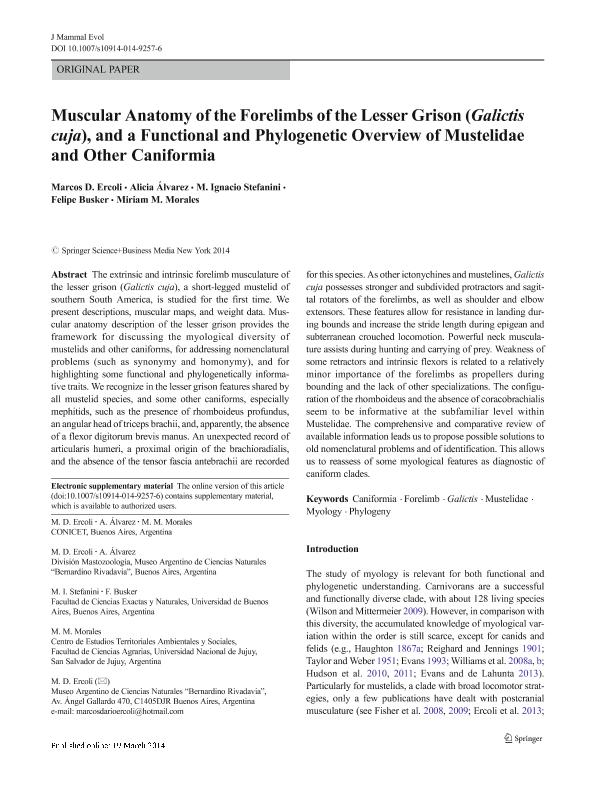Artículo
Muscular anatomy of the forelimbs of the lesser grison (Galictis cuja), and a functional and phylogenetic overview of Mustelidae and other Caniformia
Ercoli, Marcos Darío ; Alvarez, Alicia
; Alvarez, Alicia ; Stefanini, Manuel Ignacio; Busker, Felipe
; Stefanini, Manuel Ignacio; Busker, Felipe ; Morales, Miriam Mariana
; Morales, Miriam Mariana
 ; Alvarez, Alicia
; Alvarez, Alicia ; Stefanini, Manuel Ignacio; Busker, Felipe
; Stefanini, Manuel Ignacio; Busker, Felipe ; Morales, Miriam Mariana
; Morales, Miriam Mariana
Fecha de publicación:
03/2014
Editorial:
Springer
Revista:
Journal Of Mammalian Evolution
ISSN:
1064-7554
Idioma:
Inglés
Tipo de recurso:
Artículo publicado
Clasificación temática:
Resumen
The extrinsic and intrinsic forelimb musculature of the lesser grison (Galictis cuja), a short-legged mustelid of southern South America, is studied for the first time. We present descriptions, muscular maps, and weight data. Muscular anatomy description of the lesser grison provides the framework for discussing the myological diversity of mustelids and other caniforms, for addressing nomenclatural problems (such as synonymy and homonymy), and for highlighting some functional and phylogenetically informative traits. We recognize in the lesser grison features shared by all mustelid species, and some other caniforms, especially mephitids, such as the presence of rhomboideus profundus, an angular head of triceps brachii, and, apparently, the absence of a flexor digitorum brevis manus. An unexpected record of articularis humeri, a proximal origin of the brachioradialis, and the absence of the tensor fascia antebrachii are recorded for this species. As other ictonychines and mustelines, Galictis cuja possesses stronger and subdivided protractors and sagittal rotators of the forelimbs, as well as shoulder and elbow extensors. These features allow for resistance in landing during bounds and increase the stride length during epigean and subterranean crouched locomotion. Powerful neck musculature assists during hunting and carrying of prey. Weakness of some retractors and intrinsic flexors is related to a relatively minor importance of the forelimbs as propellers during bounding and the lack of other specializations. The configuration of the rhomboideus and the absence of coracobrachialis seem to be informative at the subfamiliar level within Mustelidae. The comprehensive and comparative review of available information leads us to propose possible solutions to old nomenclatural problems and of identification. This allows us to reassess of some myological features as diagnostic of caniform clades.
Palabras clave:
Caniformia
,
Forelimb
,
Galictis
,
Mustelidae
,
Myology
,
Phylogeny
Archivos asociados
Licencia
Identificadores
Colecciones
Articulos(MACNBR)
Articulos de MUSEO ARG.DE CS.NAT "BERNARDINO RIVADAVIA"
Articulos de MUSEO ARG.DE CS.NAT "BERNARDINO RIVADAVIA"
Articulos(SEDE CENTRAL)
Articulos de SEDE CENTRAL
Articulos de SEDE CENTRAL
Citación
Ercoli, Marcos Darío; Alvarez, Alicia; Stefanini, Manuel Ignacio; Busker, Felipe; Morales, Miriam Mariana; Muscular anatomy of the forelimbs of the lesser grison (Galictis cuja), and a functional and phylogenetic overview of Mustelidae and other Caniformia; Springer; Journal Of Mammalian Evolution; 22; 1; 3-2014; 57-91
Compartir
Altmétricas



